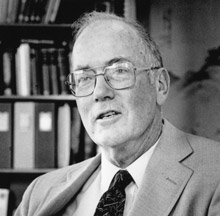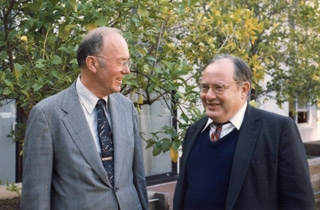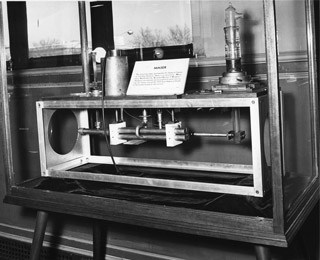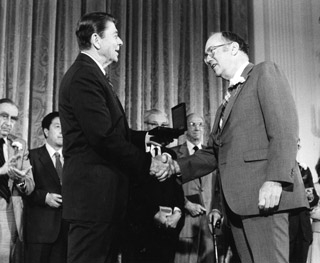
The world lost a remarkable scientist on January 27 when Charles Townes, who is most connected to the invention of the laser, passed away just six months shy of his 100th birthday.
Townes’ scientific journey that led to the concept of the laser began with his work at Columbia University on molecular spectroscopy using microwaves. The first intense microwave sources were invented during World War II and applied to early radar systems. In the postwar period, microwave technology was continually advancing for communication systems that took advantage of the higher information-carrying ability of these higher-frequency radio waves. That evolution continues today as our burgeoning cell-phone system takes advantage of gigahertz-range transmission over the short distances between handsets and cell towers.

In his oral histories archived in AIP’s Niels Bohr Library and Archives,[1] Townes recounts his “ah-ha” moment that occurred as he was sitting on a Washington, DC, park bench in 1951, pondering the problem of how to make more intense microwave radiation than could be obtained with the usual source of any form of electromagnetic radiation—a body heated to a certain temperature which emits radiation according to a well-defined spectral curve called the black body curve. By using radiation that is emitted by atoms or molecules as they are first excited to higher energy states and then forced to emit in unison, the limits of this black body curve could be greatly exceeded, and the emitted radiation could be tuned to specific wavelengths. This idea was brought to practice in the first MASER—Townes’ acronym for Microwave Amplification by Stimulated Emission of Radiation. Townes and his brother-in-law, fellow Nobel laureate Arthur Schawlow, then coauthored a seminal 1958 Physical Review paper, “Infrared and Optical Masers.” The paper predicted that the maser effect could be extended to infrared and visible light wavelengths. Thus, the concept of the laser was born.

The first experimental demonstration of the laser by Theodore Maiman in 1960 at Hughes Aircraft involved a device with a flash-lamp-excited ruby crystal that produced bright red laser light at 634.8 nm. The world celebrated the 50th anniversary of the laser in 2010, with all the ceremony appropriate for clearly one of the most important inventions of the last century. The laser is now ubiquitous: responsible for transmitting nearly all the world’s information through optical fiber networks, taking in information with scanners, delivering that information with laser printers, fabricating microelectronics, cutting and welding metals for autos and ship hulls, restoring our sight, and treating certain cancers. Those are just a few of many applications that resulted from those contemplations on a park bench.
I can trace both ends of my scientific career to Townes’ invention. As a young boy I was fascinated with the demonstration of the first ruby laser and spent three years building three different working models that convinced me I wanted to be a physicist. (I recounted my adventure in a Physics Today article during the laser’s anniversary year.)

At the other end of my career, I spent 15 years with my colleagues at Jefferson Lab building a “free electron laser” that still holds the world’s record for delivering the most power over a broadly tunable range from the infrared through the ultraviolet.[2]
AIP honored Townes with the 2000 AIP Science Writing Award for his book, How the Laser Happened: Adventures of a Scientist. Townes accepted his award at the 2000 AIP Industrial Physics Forum hosted by General Atomics. As I asked Townes to sign my copy of his book, I was able to thank him for the wonderful invention that he gave the world—an innovation that has now become his legacy. I join thousands of fellow scientists and engineers who consider Townes to be a guiding light of our careers.
Additional remembrances of Townes can be found on the APS and OSA websites.
[1] Interview with Charles Townes by William V. Smith, June 18 and 20, 1979.
Interview with Charles Townes by Joan Bromberg, January 28 and 31, 1984.
Interview with Charles Townes by Finn Aaserud, May 20 and 21, 1987.;
[2] H. F. Dylla, S. Corneliussen (August 2005). Free-Electron Lasers Come of Age—A quarter century after their invention, free-electron lasers are driving worldwide investigations. Photonics Spectra. Available: www.photonics.com/Article.aspx?AID=22472.
